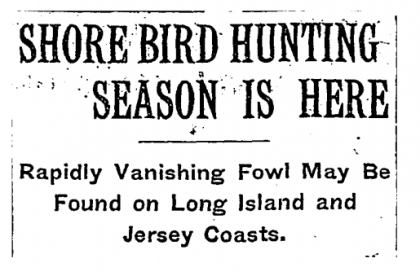
*See an updated version of this post at Cool Green Science*
In 2011, two whimbrels that were part of a migration tracking study were shot as they made landfall on the island of Guadeloupe during their south bound migration. The event shocked birders and conservationists and brought attention to the fact people are still hunting shorebirds for recreation and subsistence.
While organizations in North America are working tirelessly to help shorebirds weather the many threats shorebirds face, the very same birds are being hunted in the Caribbean and South America.
One hundred years before the death of these whimbrels, the United States began to enact laws that afforded increasing protection to shorebirds from hunting.
This New York Times headline above from 1911 is a reminder that shorebirds were once hunted in North Americans as well, for food, for sport, and for profit. The article was published at a time of widespread concern for exploited bird populations. This concern resulted in a series of laws that instituted strict protections for bird species:
In the decades prior to the passage of these laws, a tradition of shorebird hunting developed similar to duck hunting, with calls, decoys, and hunting blinds. The legacy of this tradition lives on today primarily through the art of decoy carving.
For tales of the old days of shorebird hunting in the United States, check out Game Birds of the Coasts and Lakes of the Northern States of America published in 1865 by Robert Roosevelt (Teddy’s uncle).
Many shorebird populations recovered after hunting was banned, but some shorebird populations never recovered (such as the eskimo curlew, which is extinct) and others experienced range restrictions (such as the American avocet).
The eastern willet is a great beneficiary of the hunting bans. It was extirpated from much of its range on the coast of the Northeastern U.S. but over the decades since hunting stopped, it has fully recolonized its former range.
Although hunting in the Caribbean and South America does not seem to be happening at the scale it was at the peak of North American market hunting, conservationists are still struggling to understand its impact on shorebird populations during the present day.
What conservationists do know is that habitat loss is a much greater threat than hunting to the long-term survival of shorebird populations.
Present day shorebird hunters could become allies for conservation against threats such as shrimp farming (which permanently destroys coastal habitats) because they share a stake in the continued existence of shorebirds.